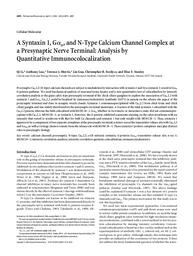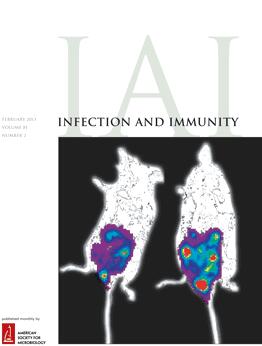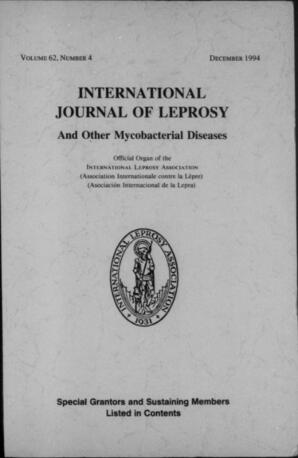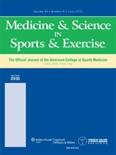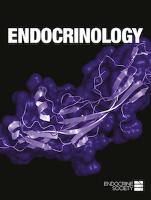Biology
Related Works
Content type
Digital Document
Abstract
Presynaptic CaV2.2 (N-type) calcium channels are subject to modulation by interaction with syntaxin 1 and by a syntaxin 1-sensitive GαO G-protein pathway. We used biochemical analysis of neuronal tissue lysates and a new quantitative test of colocalization by intensity correlation analysis at the giant calyx-type presynaptic terminal of the chick ciliary ganglion to explore the association of CaV2.2 with syntaxin 1 and GαO. CaV2.2 could be localized by immunocytochemistry (antibody Ab571) in puncta on the release site aspect of the presynaptic terminal and close to synaptic vesicle clouds. Syntaxin 1 coimmunoprecipitated with CaV2.2 from chick brain and chick ciliary ganglia and was widely distributed on the presynaptic terminal membrane. A fraction of the total syntaxin 1 colocalized with the CaV2.2 puncta, whereas the bulk colocalized with MUNC18-1. GαO, whether in its trimeric or monomeric state, did not coimmunoprecipitate with CaV2.2, MUNC18-1, or syntaxin 1. However, the G-protein exhibited a punctate staining on the calyx membrane with an intensity that varied in synchrony with that for both Ca channels and syntaxin 1 but only weakly with MUNC18-1. Thus, syntaxin 1 appears to be a component of two separate complexes at the presynaptic terminal, a minor one at the transmitter release site with CaV2.2 and GαO, as well as in large clusters remote from the release site with MUNC18-1. These syntaxin 1 protein complexes may play distinct roles in presynaptic biology.
Origin Information
Content type
Digital Document
Abstract
To study responses to Mycobacterium leprae antigens, we developed an in vitro model system in which latex particles coated with M. leprae sonic extract (MLSON) antigen were presented to monocytes. Uptake and oxidative response as measured by superoxide production to these antigens were investigated. Phagocytosis of MLSON-coated particles was greater than that of control particles in monocytes from both leprosy patients and controls from leprosy-endemic areas; uptake of MLSON-coated particles was higher in monocytes from lepromatous leprosy patients than in cells from tuberculoid leprosy patients and controls. In both patients and controls, uptake of latex particles coated with leprosy antigens triggered very little reduction of nitroblue tetrazolium although the cells were capable of mounting a respiratory burst. Antigen-coated latex particles can therefore be used as a tool to investigate monocyte responses to M. leprae and individual recombinant antigens.
Origin Information
Content type
Digital Document
Abstract
A one-tube nested polymerase chain reaction (PCR) method for the diagnosis of paucibacillary leprosy was developed using the repetitive RLEP sequence as a target. Detection of the PCR products was simplified by the adaptation of a colorimetric method. The test was specific for Mycobacterium leprae, and the sensitivity of the assay was 1 fg of purified genomic M. leprae DNA (less than one genome). Complete concordance was seen between the development of color and resolution on agarose gels. The results of frozen skin sections from untreated patients showed that the assay could detect 100% of multibacillary samples [bacterial index (BI) of 2 or more] and 69% and 70% of the samples with Bis of 1 and 0, respectively. The use of one-tube nested PCR in assessing the effectiveness of multidrug therapy (MDT) in leprosy also was determined. The simplified colorimetric assay was found to be sensitive, rapid and specific, and is suitable for use in routing diagnostic laboratories.
Origin Information
Content type
Digital Document
Abstract
Purpose: Angiopoietin-like 4 (ANGPTL4) is known to play a variety of roles in the response to exercise, and more recently has been shown to enhance the healing of tendon, a fibrous load-bearing tissue required for efficient movement. The objective of the current study was to further explore the mechanisms of ANGPTL4's effect on tendon cells using a gene array approach.
<p>Methods: Human tendon fibroblasts were treated with recANGPTL4 and their global transcriptome response analyzed after 4 and 24 h. We also conducted functional studies using tendon fibroblasts derived from human subjects, cultured in the presence or absence of applied cyclic stretch and/or siRNA for ANGPTL4, and as confirmation we also used tendon cells from wild type (ANGPTL4 +/+) or knockout (ANGPTL4-/-) mice.
<p>Results: The leading functions of ANGPTL4 predicted by the resulting pathway analysis were cell movement and proliferation. The experiments demonstrated that ANGPTL4 significantly enhanced tendon cell proliferation and the cell cycle progression, as well as adhesion and migration.
<p>Conclusion: Taken together, these findings provide novel molecular insights into the effect of ANGPTL4, a multifunctional protein that regulates the physiological response to exercise, on fundamental tendon cell functions.
Origin Information
Content type
Digital Document
Abstract
Mcl-1 (myeloid cell leukaemia-1) is a Bcl-2 family member with short-term pro-survival functions but whose other functions, demonstrated by embryonic lethality of knockout mice, do not involve apoptosis. In the present study, we show a cell-cycle-regulatory role of Mcl-1 involving a shortened form of the Mcl-1 polypeptide, primarily localized to the nucleus, which we call snMcl-1. snMcl-1 interacts with the cell-cycle-regulatory protein Cdk1 (cyclin-dependent kinase 1; also known as cdc2) in the nucleus, and Cdk1 bound to snMcl-1 was found to have a lower kinase activity. The interaction with Cdk1 occurs in the absence of its cyclin partners and is enhanced on treatment of cells with G2/M blocking agents, but not by G1/S blocking. The snMcl-1 polypeptide is present during S and G2 phases and is negligible in G1. Overexpression of human Mcl-1 in a murine myeloid progenitor cell line resulted in a lower rate of proliferation. Furthermore, Mcl-1-overexpressing cells had lower total Cdk1 kinase activity compared with parental cells, in both anti-Cdk1 and anti-cyclin B1 immunoprecipitates. The latter results suggest that binding to snMcl-1 alters the ability of Cdk1 to bind its conventional partner, cyclin B1. Given the important role of Cdk1 in progression through G2 and M phases, it is probable that the inhibition of Cdk1 activity accounts for the inhibitory effect of Mcl-1 on cell growth.
Origin Information
Content type
Digital Document
Abstract
Here we report a novel role for myeloid cell leukemia 1 (Mcl-1), a Bcl-2 family member, in regulating phosphorylation and activation of DNA damage checkpoint kinase, Chk1. Increased expression of nuclear Mcl-1 and/or a previously reported short nuclear form of Mcl-1, snMcl-1, was observed in response to treatment with low concentrations of etoposide or low doses of UV irradiation. We showed that after etoposide treatment, Mcl-1 could coimmunoprecipitate with the regulatory kinase, Chk1. Chk1 is a known regulator of DNA damage response, and its phosphorylation is associated with activation of the kinase. Transient transfection with Mcl-1 resulted in an increase in the expression of phospho-Ser345 Chk1, in the absence of any evidence of DNA damage, and accumulation of cells in G2. Importantly, knockdown of Mcl-1 expression abolished Chk1 phosphorylation in response to DNA damage. Mcl-1 could induce Chk1 phosphorylation in ATM-negative (ataxia telangectasia mutated) cells, but this response was lost in ATR (AT mutated and Rad3 related)-defective cells. Low levels of UV treatment also caused transient increases in Mcl-1 levels and an ATR-dependent phosphorylation of Chk1. Together, our results strongly support an essential regulatory role for Mcl-1, perhaps acting as an adaptor protein, in controlling the ATR-mediated regulation of Chk1 phosphorylation.
Origin Information
Content type
Digital Document
Abstract
Gonadal steroids are potent regulators of adult neurogenesis. We previously reported that androgens, such as testosterone (T) and dihydrotestosterone (DHT), but not estradiol, increased the survival of new neurons in the dentate gyrus of the male rat. These results suggest androgens regulate hippocampal neurogenesis via the androgen receptor (AR). To test this supposition, we examined the role of ARs in hippocampal neurogenesis using 2 different approaches. In experiment 1, we examined neurogenesis in male rats insensitive to androgens due to a naturally occurring mutation in the gene encoding the AR (termed testicular feminization mutation) compared with wild-type males. In experiment 2, we injected the AR antagonist, flutamide, into castrated male rats and compared neurogenesis levels in the dentate gyrus of DHT and oil-treated controls. In experiment 1, chronic T increased hippocampal neurogenesis in wild-type males but not in androgen-insensitive testicular feminization mutation males. In experiment 2, DHT increased hippocampal neurogenesis via cell survival, an effect that was blocked by concurrent treatment with flutamide. DHT, however, did not affect cell proliferation. Interestingly, cells expressing doublecortin, a marker of immature neurons, did not colabel with ARs in the dentate gyrus, but ARs were robustly expressed in other regions of the hippocampus. Together these studies provide complementary evidence that androgens regulate adult neurogenesis in the hippocampus via the AR but at a site other than the dentate gyrus. Understanding where in the brain androgens act to increase the survival of new neurons in the adult brain may have implications for neurodegenerative disorders. Part of the "Neuroendocrinology" issue.
Origin Information
Content type
Digital Document
Abstract
Small-subunit ribosomal DNA (SSU) sequences for 14 members of the rhodophyte order Acrochaetiales were used to generate phylogenetic trees to determine whether the Acrochaetiales is monophyletic and to assess the relationships of acrochaetioid algae to closely related taxa. Within the Acrochaetiales, two strongly supported groups are recognized: one group that includes, in addition to three other species, the type species of the genera Acrochaetium, Audouinella and Rhodochorton; and a second group that includes an unequivocal representative of Colaconema and nine additional species. The relationships of these groups with the Batrachospermales, Palmariales and Nemaliales were not resolved and the possibility that the Acrochaetiales is polyphyletic was not eliminated. Resolution of relationships for species within these groups was strong in only a few cases, with many of the phylogenetic issues at this level remaining equivocal. Our results do not position Camontagnea in the Acrochaetiales, as has recently been suggested, but strongly ally this genus to the family Rhodothamniellaceae of the Palmariales. The phylogenetic position of Rhododraparnaldia, an alga intermediate between the Acrochaetiales and Batrachospermales, remains unresolved. These molecular results provide a foundation for assessing the taxonomic significance of phenotypic characters (e.g. anatomy, life histories, morphology, phycoerythrin type and plastid details) variously considered taxonomically significant in the Acrochaetiales.
Origin Information
Content type
Digital Document
Abstract
Systematics of the red algal order Acrochaetiales and related taxa was investigated using combined small- and large-subunit nuclear ribosomal DNA (SSU and LSU rDNA, respectively) sequence data. These data were subjected to distance, parsimony and maximum likelihood analyses. The resulting phylogenies were congruent with previously published SSU results in that all included orders (Balbianiales, Batrachospermales, Nemaliales, Palmariales and Thoreales) were resolved as monophyletic except the Acrochaetiales, which consisted of two lineages (Acrochaetiales I and II). The Batrachospermales and Thoreales occupied equivocal positions as early diverging lineages, while the Balbianiales generally resolved as sister to an Acrochaetiales–Nemaliales–Palmariales (ANP) complex. Relationships among the four lineages of the ANP complex were not completely resolved, but detailed analyses weakly positioned Acrochaetiales II as sister to the Nemaliales, whereas Acrochaetiales I displayed a moderate to strong affiliation with the Palmariales. Acrochaetiales I included representatives of the genera Acrochaetium, Audouinellaand Rhodochorton, whereas Acrochaetiales II had a number of acrochaetioid species including a representative of the genus Colaconema. Compared with published SSU phylogenies, bootstrap values within the two Acrochaetiales lineages increased substantially in combined SSU/LSU analyses. Based on these results, emended generic descriptions are provided for Acrochaetium, Audouinella, Colaconemaand Rhodochorton, and a new family of acrochaetioid algae is described, the Colaconemataceae J. T. Harper etG. W. Saunders. The Acrochaetiaceae now includes the genera Acrochaetium, Audouinellaand Rhodochorton, while the Colaconemataceae is considered monogeneric at this time. It is quite likely that additional genera will be recognized within the Colaconemataceae pending further investigation. Acrochaetiaceae is retained as the sole family of the Acrochaetiales, although the tenuous recognition of the Palmariales as distinct from this order is discussed, whereas Colaconemataceae is transferred to the new order Colaconematales J. T. Harper et G. W. Saunders.
Origin Information
Content type
Digital Document
Abstract
Background: Lateral gene transfer is increasingly invoked to explain phylogenetic results that conflict with our understanding of organismal relationships. In eukaryotes, the most common observation interpreted in this way is the appearance of a bacterial gene (one that is not clearly derived from the mitochondrion or plastid) in a eukaryotic nuclear genome. Ideally such an observation would involve a single eukaryote or a small group of related eukaryotes encoding a gene from a specific bacterial lineage.
<p>Results: Here we show that several apparently simple cases of lateral transfer are actually more complex than they originally appeared: in these instances we find that two or more distantly related eukaryotic groups share the same bacterial gene, resulting in a punctate distribution. Specifically, we describe phylogenies of three core carbon metabolic enzymes: transketolase, glyceraldehyde-3-phosphate dehydrogenase and ribulose-5-phosphate-3-epimerase. Phylogenetic trees of each of these enzymes includes a strongly-supported clade consisting of several eukaryotes that are distantly related at the organismal level, but whose enzymes are apparently all derived from the same lateral transfer. With less sampling any one of these examples would appear to be a simple case of bacterium-to-eukaryote lateral transfer; taken together, their evolutionary histories cannot be so simple. The distributions of these genes may represent ancient paralogy events or genes that have been transferred from bacteria to an ancient ancestor of the eukaryotes that retain them. They may alternatively have been transferred laterally from a bacterium to a single eukaryotic lineage and subsequently transferred between distantly related eukaryotes.
<p>Conclusion: Determining how complex the distribution of a transferred gene is depends on the sampling available. These results show that seemingly simple cases may be revealed to be more complex with greater sampling, suggesting many bacterial genes found in eukaryotic genomes may have a punctate distribution.
Origin Information

